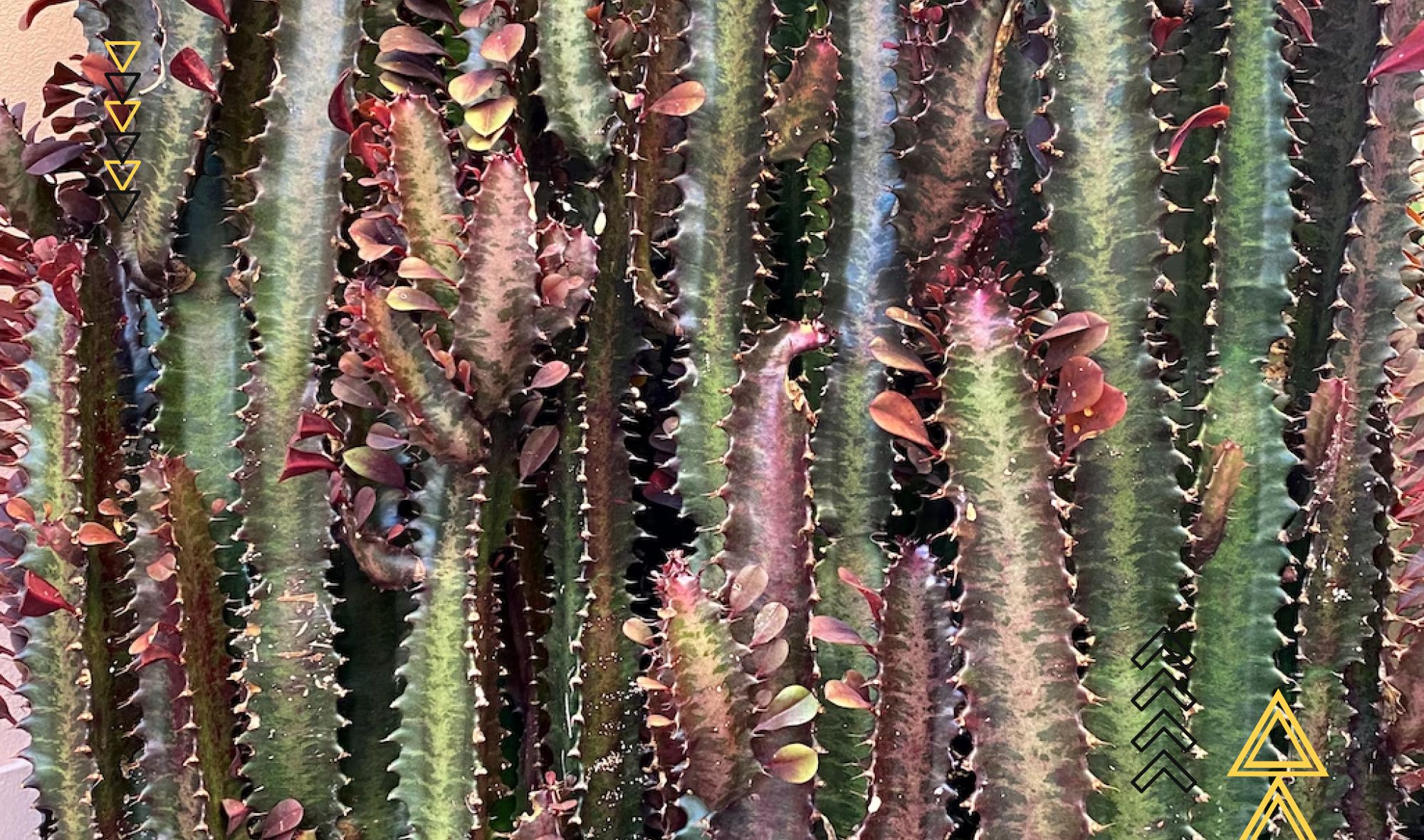How to Care for African Milk Tree: The Essential Guide
By HeyHome • July 17, 2023
Key Takeaways
- African Milk Tree is a unique and stunning succulent with triangular stems.
- Ideal growing conditions include bright indirect light, well-draining soil, and careful watering.
- Regular care tasks include temperature and humidity control, fertilizing, pruning, and potting.
- The plant can be propagated from cuttings, though it's challenging from seeds.
- It's essential to identify and treat common pests and diseases to maintain the plant's health.

Have you ever heard of a plant that combines the elegance of a cactus with the easy care of a succulent? Meet the African Milk Tree (Euphorbia trigona), a unique and captivating plant that brings the charm of the African wilderness into your living space. Often mistaken for a cactus, this spectacular plant hailing from West Africa boasts attractive triangular stems that easily earns it the affectionate names of 'candelabra cactus' or 'friendship cactus'.
The African Milk Tree is more than just an exotic showpiece—it's a testament to the resilience and adaptability of nature. Noted for its drought-resistant characteristics, it’s also a popular plant among succulent enthusiasts for its easy propagation and striking appearance. In this comprehensive guide, we'll delve into everything you need to know about the African Milk Tree care—from growing conditions, propagation, to troubleshooting common issues.
Whether you're a seasoned green thumb looking to diversify your plant collection or a newbie contemplating your first foray into the enchanting world of succulents, our essential guide will empower you with the necessary knowledge to nurture your African Milk Tree. So, are you ready to take on the rewarding journey of caring for this exotic wonder? Let’s dive in!
Read more on our blog about various plants and tips to enhance your green thumb.
Join our newsletter
Stay on top of the latest in landscaping and lawn care with one valuable tip right in your inbox every Saturday morning.
Understanding the African Milk Tree
The African Milk Tree, scientifically known as Euphorbia trigona, hails from the diverse continent of Africa. Precisely, it originates from the dry, sun-baked terrains of West Africa, embodying the resilience and tenacity characteristic of plants from this region.
A member of the diverse Euphorbiaceae family, this plant stands out due to its unique triangular stems, lending it an architectural allure. Covered in leaves with a rich, glossy texture, these stems house a milky sap that is a trademark of this species—hence, the name African Milk Tree.
It's essential to distinguish the African Milk Tree from similar-looking plants, such as the African Cactus and Milk Cactus. While they share certain characteristics, these plants have distinct traits. The African Cactus, for example, features prominent spikes and tends to require slightly different care. The Milk Cactus, on the other hand, is another term often used to describe the African Milk Tree due to its milky sap.
Comparatively, the African Milk Tree has a slightly more bushy appearance, often with numerous branching triangular stems. Its leaves are green, often with a darker or reddish hue, especially the popular Rubra or Royal Red cultivar. It’s a plant that’s both aesthetic and adaptable, thriving in various conditions with a little care.
The Euphorbiaceae family is known for its variety, boasting a diverse range of succulents and flowering plants. For more insights into this fascinating family of plants, visit our detailed guide on Understanding the Euphorbiaceae Family.
In the following sections, we will dive deeper into how to provide the best care for your African Milk Tree, covering aspects such as light requirements, watering, temperature, and common issues to watch out for.
Let’s start our African Milk Tree care journey with one of the most crucial factors for its growth: light.
Growing African Milk Tree

Growing an African Milk Tree in your home or garden is a rewarding endeavor, as these robust plants can add a unique touch of greenery to any space. To ensure healthy growth, it's essential to meet the plant's basic needs: light, soil, and water.
Ideal Growing Conditions for African Milk Tree
Light Requirements: The African Milk Tree, akin to a good luck cactus or a friendship cactus, thrives in bright, indirect sunlight. Direct sunlight may cause leaf scorching, so it's best to position your plant in a well-lit area that doesn't receive intense midday sun.
Soil Requirements: As a drought-resistant plant native to arid regions, the African Milk Tree prefers well-draining soil that won't retain excess water. A mix of standard potting soil and perlite, or a specific succulent and cactus mix, will provide an ideal growing medium.
Water Requirements: Watering is a crucial aspect of African Milk Tree care. The plant's water needs will change with the seasons—during the growing season (spring and summer), water the plant thoroughly, allowing the soil to dry out completely between waterings. During the dormant season (fall and winter), watering should be reduced.
Join our newsletter
Stay ahead of the curve in all things outdoor.
Get the inside scoop on the latest landscaping, lawn care, and fencing trends with 1 actionable tip every Saturday morning.
Common Issues in Growing African Milk Tree
Like any plant, the African Milk Tree can face a few common issues:
Overwatering: The most common problem for these succulents is overwatering, which can lead to root rot. If your plant's leaves are yellowing or dropping off, it might be receiving too much water. Adjust your watering schedule, ensuring the soil dries out fully between each watering.
Underwatering: Conversely, underwatering can cause the plant to become dehydrated, leading to wilting or shriveled leaves. If your African Milk Tree shows these signs, it may need more frequent watering.
Temperature Changes: These plants can withstand a range of temperatures, but sudden fluctuations can be stressful. Try to keep your African Milk Tree in an environment with stable temperatures, away from drafty windows or vents.
A healthy African Milk Tree starts with the right foundation, and the soil you choose can make a significant difference. For a detailed comparison between the two most common soil types, refer to our article, Fill Dirt vs Topsoil.
In the following sections, we will discuss how to care for your African Milk Tree, including details on propagating and potting your plant, to ensure it thrives for years to come.
African Milk Tree Care Essentials

Caring for your African Milk Tree involves more than just providing it with water, light, and soil. Regular care tasks, such as temperature and humidity control and fertilizer application, and special tasks like pruning and repotting, can help your plant thrive.
Regular Care Tasks
Temperature and Humidity Control: The African Milk Tree can tolerate a wide range of temperatures, but prefers conditions similar to its native African climate: warm temperatures and low humidity. Keep your plant in a room where the temperature ranges from 60°F to 75°F. Avoid drafty areas or sudden temperature changes.
Fertilizer Application: While African Milk Trees are not heavy feeders, they benefit from occasional fertilization during the growing season (spring and summer). Use a balanced, water-soluble fertilizer diluted to half strength, and apply it once a month.
Special Care Tasks
Pruning: Pruning your African Milk Tree will help it maintain a balanced, attractive shape, and can also encourage bushier growth. Use clean, sharp pruning shears to remove any dead or diseased branches, or to trim the plant back if it becomes too tall or leggy.
Potting and Repotting: Initially, pot your African Milk Tree in a container with ample drainage holes, using a well-draining soil mix. Repot the plant every 2 to 3 years or when it outgrows its current pot. This not only provides the plant with fresh soil but also allows you to check the root health and remove any dead or decayed roots.
Overwintering African Milk Tree
As winter approaches, it's crucial to adjust the care for your African Milk Tree. Move your plant to a bright, cool spot (around 55°F to 60°F), and reduce watering to once a month. Don't fertilize the plant during this dormancy period. Resume the normal care routine when spring arrives.
Proper plant care involves understanding your plant's needs and adjusting your care routine to match. Each plant has its unique requirements. For example, for information on a different but equally interesting plant, refer to our detailed guide on Taking Care of Monstera Albo.
Propagating African Milk Tree

Propagation is the process of creating a new plant from an existing one. For the African Milk Tree, the most successful method of propagation is through cuttings. Although seed propagation is possible, it's more challenging and time-consuming. Below, we delve into these propagation methods in more detail.
Propagating from Cuttings
Follow these steps for successful propagation of your African Milk Tree:
- Choose a Healthy Stem: Start by selecting a healthy, disease-free stem from your African Milk Tree. It should be mature, but not overly woody.
- Make the Cut: Using a sharp, sterile knife, make a cut at a 45-degree angle. The cutting should be about 4-6 inches long.
- Let it Dry: This is crucial. Allow the cutting to dry for a few days to form a callus. This helps to prevent rot when you plant the cutting.
- Plant the Cutting: Once the cut has dried, plant your cutting in a well-draining cactus or succulent mix.
- Care for Your New Plant: Place the newly planted cutting in a bright, warm location out of direct sunlight. Water sparingly until you see new growth, indicating that the cutting has rooted.
Propagating from Seeds
While it's possible to grow an African Milk Tree from seeds, this method tends to be more challenging. Germinating Euphorbia trigona seeds requires a constant temperature of around 70°F to 75°F and a specific light intensity. Even with these conditions, germination rates can be low, and the seedlings require careful handling due to their delicate nature.
If you're looking for other interesting plants to propagate, why not try your hand at the Neon Pothos? This vibrant, hardy houseplant can add a pop of color to any space. Check out our guide on Mastering Neon Pothos Care for tips on propagation and more.
Dealing with Common Pests and Diseases

Even with the best care, your African Milk Tree may sometimes encounter issues with pests and diseases. In this section, we'll identify some common problems and provide solutions to keep your plant thriving.
Common Pests
Mealybugs are one of the most common pests that affect African Milk Trees. They are small, white, and have a cotton-like appearance. If not treated, they can quickly multiply and sap the plant's vitality. Treat a mealybug infestation by wiping the plant with a cotton swab dipped in rubbing alcohol.
Spider Mites are tiny insects that can also plague your African Milk Tree. They are harder to see but can be identified by the thin, silky web they weave on the plant. Washing the plant with a mild soap solution or using a miticide can help control these pests.
Common Diseases
Root Rot is the most common disease that can affect your African Milk Tree, often due to overwatering. Symptoms include wilting, yellowing leaves, and a stale smell from the soil. The best way to treat root rot is by repotting the plant in fresh, well-draining soil. To prevent root rot, ensure your plant has adequate drainage and is not watered excessively.
Powdery Mildew can occur if the plant is kept in high humidity without enough air circulation. It manifests as a white powdery substance on the leaves. To treat it, remove the affected parts and treat the plant with a fungicide. Keep the plant in a well-ventilated area to prevent recurrence.
Dealing with pests and diseases can be tricky, but with timely identification and treatment, your African Milk Tree can bounce back to health. If you're looking for more insights on dealing with plant pests and diseases, consider reading about the care of other houseplants.
Frequently Asked Questions

In this section, we address some commonly asked questions about the African Milk Tree, providing additional insights into its care and upkeep.
Can the African Milk Tree be grown indoors?
Yes, absolutely. The African Milk Tree is an ideal indoor plant because it thrives in a variety of light conditions and prefers indoor temperatures.
How often should I water my African Milk Tree?
The African Milk Tree is drought-resistant and prefers to dry out between watering. In warmer months, watering once every two weeks should be sufficient, and in cooler months, you can reduce this to once a month. Remember, it's better to underwater than overwater this plant.
My African Milk Tree's leaves are turning yellow. What does this mean?
Yellowing leaves are often a sign of overwatering. Reduce watering frequency and ensure the plant has proper drainage. If the problem persists, you may need to repot the plant into fresh soil.
How do I propagate an African Milk Tree?
The easiest way to propagate an African Milk Tree is from cuttings. For more detailed instructions, refer to our propagation section above.
Can my African Milk Tree survive in low light conditions?
The African Milk Tree can tolerate low light conditions, but it thrives best in bright, indirect light. In low light, the plant may grow more slowly and the stems may become leggy.
How often should I fertilize my African Milk Tree?
Generally, you should fertilize your African Milk Tree once every four weeks during the growing season (spring and summer). During the fall and winter months, reduce fertilization to once every 8-10 weeks.
Remember, every plant is unique and may not follow the 'rules' perfectly. Always pay attention to the specific needs and signs your plant is giving you.
Conclusion
Throughout this comprehensive guide, we've explored the fascinating world of the African Milk Tree, a stunning and resilient member of the Euphorbia trigona family. With its unique aesthetic appeal and relatively easy care routine, it's an excellent addition to any plant collection, whether you're a seasoned horticulturist or a budding green thumb.
We've dived deep into the origins and unique characteristics of this 'candelabra cactus' and how it compares to similar plants in the succulent family. We've walked you through the ideal growing conditions, detailing the plant's light, soil, and water needs, and addressing common issues you may face, like overwatering and temperature fluctuations.
Our care essentials section offered insights into regular and special tasks, including temperature and humidity control, fertilizer application, pruning, and potting. We've also shed light on overwintering this 'good luck cactus' and how to propagate it efficiently.
An understanding of common pests and diseases that could afflict your African Milk Tree will equip you to respond proactively and maintain the health of your plant. And, of course, we've endeavored to answer some of your most frequently asked questions to provide you with a well-rounded understanding of this intriguing plant.
With all this knowledge, we hope you feel inspired and well-prepared to embark on the rewarding journey of caring for an African Milk Tree. As with all plants, the process requires patience and attentiveness, but the outcome—a flourishing, vibrant plant—is undoubtedly worth the effort.
For more information and tips on plant care, don't hesitate to visit our Heyhome Blog. Here, you'll find a wealth of resources to support you in your gardening journey. Happy growing!
Remember, every plant has a story, and as a plant parent, you're a significant part of it. Here's to growing our green family together!
Join our newsletter
Stay ahead of the curve in all things outdoor.
Get the inside scoop on the latest landscaping, lawn care, and fencing trends with 1 actionable tip every Saturday morning.